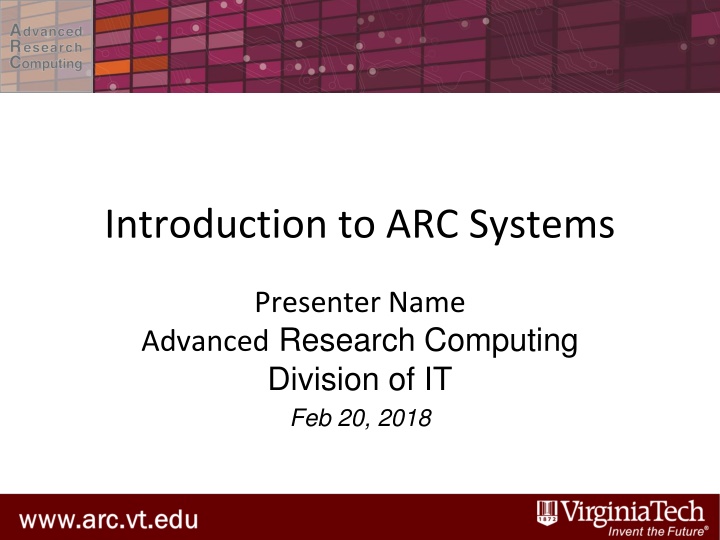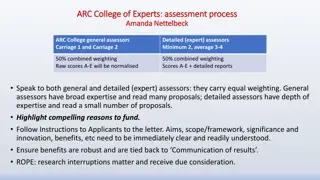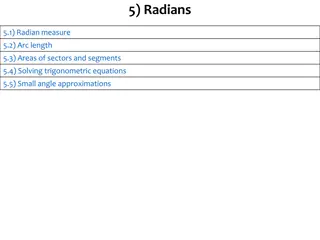
Exploring High-Performance Computing in Advanced Research Computing Systems
Discover the world of High-Performance Computing (HPC) through an overview of ARC systems, goals, software packages, research areas, and user statistics. Learn about the broad applications of HPC, its necessity, popular software packages, and the learning curve involved. Determine if pursuing HPC is the right choice for your computational needs and collaborations.
Download Presentation

Please find below an Image/Link to download the presentation.
The content on the website is provided AS IS for your information and personal use only. It may not be sold, licensed, or shared on other websites without obtaining consent from the author. If you encounter any issues during the download, it is possible that the publisher has removed the file from their server.
You are allowed to download the files provided on this website for personal or commercial use, subject to the condition that they are used lawfully. All files are the property of their respective owners.
The content on the website is provided AS IS for your information and personal use only. It may not be sold, licensed, or shared on other websites without obtaining consent from the author.
E N D
Presentation Transcript
Introduction to ARC Systems Presenter Name Advanced Research Computing Division of IT Feb 20, 2018
Before We Start Sign in Request account if necessary Windows Users: MobaXterm PuTTY Web Interface: ETX newriver.arc.vt.edu
Todays goals Introduce ARC Give overview of HPC today Give overview of VT-HPC resources Familiarize audience with interacting with VT-ARC systems
Should I Pursue HPC? Necessity: Are local resources insufficient to meet your needs? Very large jobs Very many jobs Large data Convenience: Do you have collaborators? Share projects between different entities Convenient mechanisms for data sharing 4
Research in HPC is Broad Earthquake Science and Civil Engineering Molecular Dynamics Nanotechnology Plant Science Storm modeling Epidemiology Particle Physics Economic analysis of phone network patterns Brain science Analysis of large cosmological simulations DNA sequencing Computational Molecular Sciences Neutron Science International Collaboration in Cosmology and Plasma Physics 5 5
Who Uses HPC? >2 billion core-hours allocated 1400 allocations 350 institutions 32 research domains
Popular Software Packages Molecular Dynamics: Gromacs, LAMMPS, NAMD, Amber CFD: OpenFOAM, Ansys, Star-CCM+ Finite Elements: Deal II, Abaqus Chemistry: VASP, Gaussian, PSI4, QCHEM Climate: CESM Bioinformatics: Mothur, QIIME, MPIBLAST Numerical Computing/Statistics: R, Matlab, Julia Visualization: ParaView, VisIt, Ensight Deep Learning: Caffe, TensorFlow, Torch, Theano
Learning Curve Linux: Command-line interface Scheduler: Shares resources among multiple users Parallel Computing: Need to parallelize code to take advantage of supercomputer s resources Third party programs or libraries make this easier
Advanced Research Computing Unit within the Office of the Vice President of Information Technology Provide centralized resources for: Research computing Visualization Staff to assist users Website: http://www.arc.vt.edu
ARC Goals Advance the use of computing and visualization in VT research Centralize resource acquisition, maintenance, and support for research community Provide support to facilitate usage of resources and minimize barriers to entry Enable and participate in research collaborations between departments
Personnel Associate VP for Research Computing: Terry Herdman Director, HPC: Terry Herdman Director, Visualization: Nicholas Polys Computational Scientists John Burkhardt Justin Krometis James McClure Srijith Rajamohan Bob Settlage Ahmed Ibrahim
Personnel (Continued) System Administrators (UAS) Matt Strickler Josh Akers Solutions Architects Brandon Sawyers Chris Snapp Business Manager: Alana Romanella User Support GRAs: Mai Dahshan, Negin Forouzesh, Xiaolong Li.
Personnel (Continued) System & Software Engineers Nathan Liles Open
Computational Resources NewRiver Cluster targeting data-Intensive problems DragonsTooth jobs that don't require low latency interconnect i.e. pleasingly parallel long running, e.g. 30 day wall time Blue Ridge Large scale cluster equipped with Intel Xeon Phi Co- Processors Cascades large general compute with GPU nodes Huckleberry - Machine Learning cluster Cloud based access (bring your user story)
Compute Resources System Usage Nodes Node Description Special Features 16 cores, 64 GB (2 Intel Sandy Bridge) 260 Intel Xeon Phi 4 K40 GPU 18 128GB nodes Large-scale CPU, MIC BlueRidge 408 8 K80 GPGPU 16 big data nodes 24 512GB nodes 2 3TB nodes 40 P100 nodes Large-scale, Data Intensive 24 cores, 128 GB (2 Intel Haswell) NewRiver 134 Pleasingly parallel, long jobs 2TB SSD local storage 30 day walltime 24 cores, 256 GB (2 Intel Haswell) DragonsTooth 48 Power 8, 256 GB (2x IBM Minsky S822LC) 4xP100 / Node NVLink Huckleberry DeepLearning 14
Computational Resources Name NewRiver DragonsTooth BlueRidge Huckleberry Pleasingly parallel, long running jobs Key Features, Uses Scalable CPU, Data Intensive Scalable CPU or MIC DeepLearning Available August 2015 August 2016 March 2013 Supt 2017 Theoretical Peak (TFlops/s) 152.6 .806 398.7 Nodes 134 48 408 14 Cores 3,288 576 6,528 Cores/Node 24 24 16 260 Intel Xeon Phi 8 Nvidia K40 GPU Accelerators/Co processors 8 Nvidia K80 GPU 56 Nvidia P100 GPUs N/A Memory Size 34.4 TB 12.3 TB 27.3 TB Memory/Core 5.3 GB* 10.6 GB 4 GB* Memory/Node 128 GB* 256 GB 64 GB* 512 GB
NewRiver 134 Nodes 3,288 Cores 34.4 TB Memory EDR InfiniBand (IB) Interconnect Data-intensive, large-memory, visualization, and GPGPU special-purpose hardware 8 K80 GPGPU 16 big data nodes 24 512GB nodes 2 3TB nodes 40 dual P100 nodes
NewRiver Nodes Other Features Description # Hosts CPU Cores Memory Local Disk 2 x E5-2680 v3 (Haswell) 128 GB, 2133 MHz General 100 nr027-nr126 24 1.8 TB 2 x E5-2680 v3 (Haswell) 3.6 TB (2 x 1.8 TB) NVIDIA K80 GPU GPU 8 nr019-nr026 24 512 GB 2 x E5-2680 v3 (Haswell) 43.2 TB (24 x 1.8 TB) 2x 200 GB SSD I/O 16 nr003-nr018 24 512 GB 4 x E7-4890 v2 (Ivy Bridge) 10.8 TB (6 x 1.8 TB) Large Memory 2 nr001-nr002 60 3 TB newriver1- newriver8 2 x E5-2680 v3 (Haswell) NVIDIA K1200 GPU Interactive 8 24 256 GB
Storage Resources Environment Variable Per User Maximum Data Lifespan Name Intent File System Available On 500 GB (NewRiver) 100 GB (Other) Long-term storage of files GPFS Login and Compute Nodes Home (NewRiver) NFS (Other) $HOME Unlimited Shared Data Storage for Research Groups 10 TB Free per faculty researcher Login and Compute Nodes GPFS Group $GROUP Unlimited (NewRiver) GPFS 20 TB (NewRiver) 14 TB (Other) Fast I/O, Temporary storage (NewRiver) Lustre (BlueRidge) GPFS (Other) Login and Compute Nodes Work $WORK 120 days 3 million files
Storage Resources (continued) Environment Variable Per User Maximum Data Lifespan Name Intent File System Available On Long-term storage for infrequently- accessed files Archive CXFS $ARCHIVE - Unlimited Login Nodes Local disk (hard drives) Size of node hard drive Compute Nodes Local Scratch $TMPDIR Length of Job Memory (tmpfs) Memory (RAM) Size of node memory Compute Nodes Very fast I/O $TMPFS Length of Job
Visualization Resources VisCube: 3D immersive environment with three 10 by 10 walls and a floor of 1920 1920 stereo projection screens DeepSix: Six tiled monitors with combined resolution of 7680 3200 ROVR Stereo Wall AISB Stereo Wall
Getting Started with ARC Review ARC s system specifications and choose the right system(s) for you Specialty software Apply for an account online the Advanced Research Computing website When your account is ready, you will receive confirmation from ARC s system administrators
Resources ARC Website: http://www.arc.vt.edu ARC Compute Resources & Documentation: http://www.arc.vt.edu/hpc New Users Guide: http://www.arc.vt.edu/newusers Frequently Asked Questions: http://www.arc.vt.edu/faq Linux Introduction: http://www.arc.vt.edu/unix
Thank you Questions?
Log In Log in via SSH Mac/Linux have built-in client Windows need to download client (e.g. PuTTY) System Login Address (xxx.arc.vt.edu) NewRiver newriver1 to newriver8 Dragonstooth dragonstooth1 BlueRidge blueridge1 or blueridge2 HokieSpeed hokiespeed1 or hokiespeed2 HokieOne hokieone
Browser-based Access Browse to http://newriver.arc.vt.edu Xterm: Opens an SSH session with X11 forwarding (but faster) Other profiles: VisIt, ParaView, Matlab, Allinea Create your own!
Allocations System unit (roughly, core-hour) account that tracks system usage Applies only to NewRiver and BlueRidge http://www.arc.vt.edu/allocations
Allocation System: Goals Track projects that use ARC systems and document how resources are being used Ensure that computational resources are allocated appropriately based on needs Research: Provide computational resources for your research lab Instructional: System access for courses or other training events
Allocation Eligibility To qualify for an allocation, you must meet at least one of the following: Be a Ph.D. level researcher (post-docs qualify) Be an employee of Virginia Tech and the PI for research computing Be an employee of Virginia Tech and the co-PI for a research project led by non-VT PI
Allocation Application Process Create a research project in ARC database Add grants and publications associated with project Create an allocation request using the web- based interface Allocation review may take several days Users may be added to run jobs against your allocation once it has been approved
Allocation Tiers Research allocations fall into three tiers: Less than 200,000 system units (SUs) 200 word abstract 200,000 to 1 million SUs 1-2 page justification More than 1 million SUs 3-5 page justification
Allocation Management Web-based: User Dashboard -> Projects -> Allocations Systems units allocated/remaining Add/remove users Command line: Allocation name and membership: glsaccount Allocation size and amount remaining: gbalance -h - a <name> Usage (by job): gstatement -h -a <name>
Consistent Environment Operating system (CentOS) Storage locations Scheduler Hierarchical module tree for system tools and applications
Modules Modules are used to set the PATH and other environment variables Modules provide the environment for building and running applications Multiple compiler vendors (Intel vs GCC) and versions Multiple software stacks: MPI implementations and versions Multiple applications and their versions An application is built with a certain compiler and a certain software stack (MPI, CUDA) Modules for software stack, compiler, applications User loads the modules associated with an application, compiler, or software stack modules can be loaded in job scripts
Module commands Command Result module List options module list List loaded modules module avail List available modules module load <module> Add a module module unload <module> Remove a module module swap <mod1> <mod2> Swap two modules module help <module> Module environment module show <module> Module description module spider <module> Search modules module reset Reset to default module purge Unload all modules
Modules Available modules depend on: The compiler (eg. Intel, gcc) and The MPI stack selected Defaults: BlueRidge: Intel + mvapich2 NewRiver, DragonsTooth: none
JOB SUBMISSION & MONITORING 40
Cluster System overview Compute Node 1 User Login Node VT Campus Storage /home /work Compute Node 2 VPN Internet Compute Node 3 Off- Campus Compute Node N
Cluster System Architecture internet TopSpin 120 1 Login Nodes 1 TopSpin 270 2 2950 InfiniBand Switch Hierarchy 2 Home Server Raid 5 HO ME 130 1 2 TopSpin 120 16 GigE InfiniBand I/O Nodes WORK File System GigE Switch Hierarchy Fibre Channel
Parallelism is the New Moores Law Power and energy efficiency impose a key constraint on design of micro-architectures Clock speeds have plateaued Hardware parallelism is increasing rapidly to make up the difference
Essential Components of HPC Supercomputing resources Storage Visualization Data management Network infrastructure Support 44
Terminology Core: A computational unit Socket: A single CPU ( processor ). Includes roughly 4-15 cores. Node: A single computer . Includes roughly 2-8 sockets. Cluster: A single supercomputer consisting of many nodes. GPU: Graphics processing unit. Attached to some nodes. General purpose GPUs (GPGPUs) can be used to speed up certain kinds of codes. Xeon Phi: Intel s product name for its GPU competitor. Also called MIC .
Blade : Rack : System 1 node 1 chassis 1 rack (frame): 4 chassis = 640 cores system : 10 racks = 6,400 cores : 2 x 8 cores= 16 cores : 10 nodes = 160 cores x 4 x 10
HPC Storage 200TB NFS NFS NFS $HOME $SHARE Compute Node GPFS GPFS $WORK DMF GPFS GPFS $SCRATCH Tape archive HPC Cluster Storage Gateway 140TB
Shared vs. Distributed memory M M M M M Memory P P P P P P P P P P Network Memory is local to each processor Data exchange by message passing over a network Example: Clusters with single-socket blades All processors have access to a pool of shared memory Access times vary from CPU to CPU in NUMA systems Example: SGI UV, CPUs on same node
Multi-core systems Memory Memory Memory Memory Memory Network Current processors place multiple processor cores on a die Communication details are increasingly complex Cache access Main memory access Quick Path / Hyper Transport socket connections Node to node connection via network
Accelerator-based Systems Memory Memory Memory Memory G P U G P U G P U G P U Network Calculations made in both CPUs and GPUs No longer limited to single precision calculations Load balancing critical for performance Requires specific libraries and compilers (CUDA, OpenCL) Co-processor from Intel: MIC (Many Integrated Core)






















